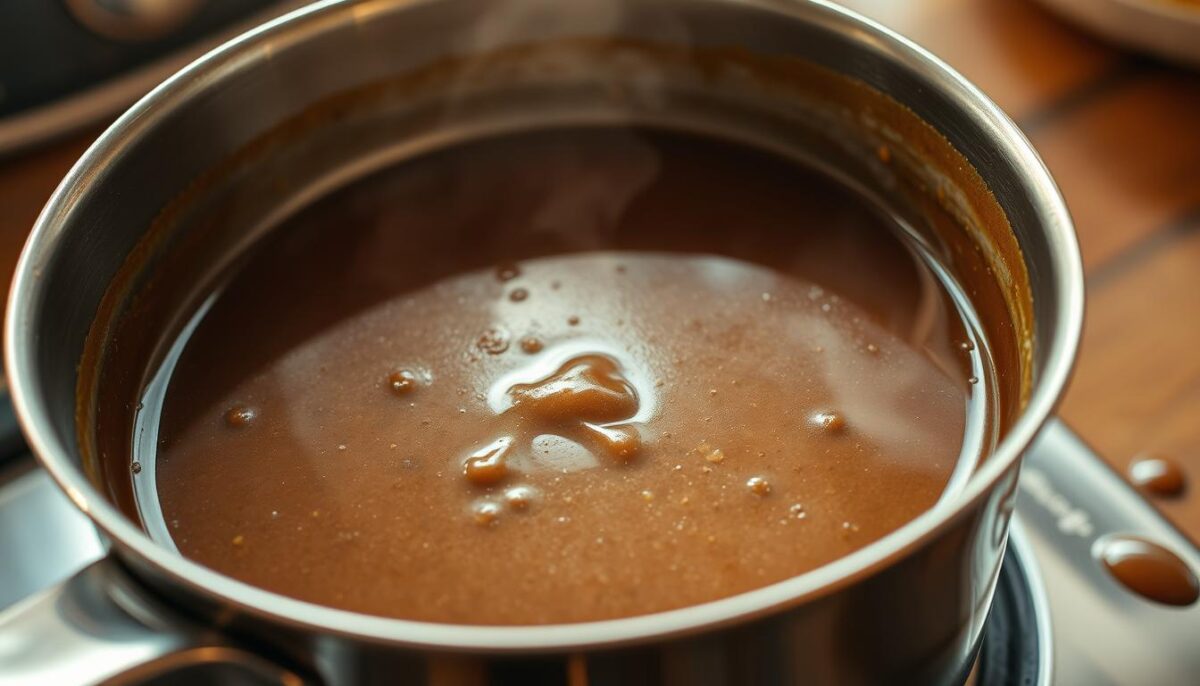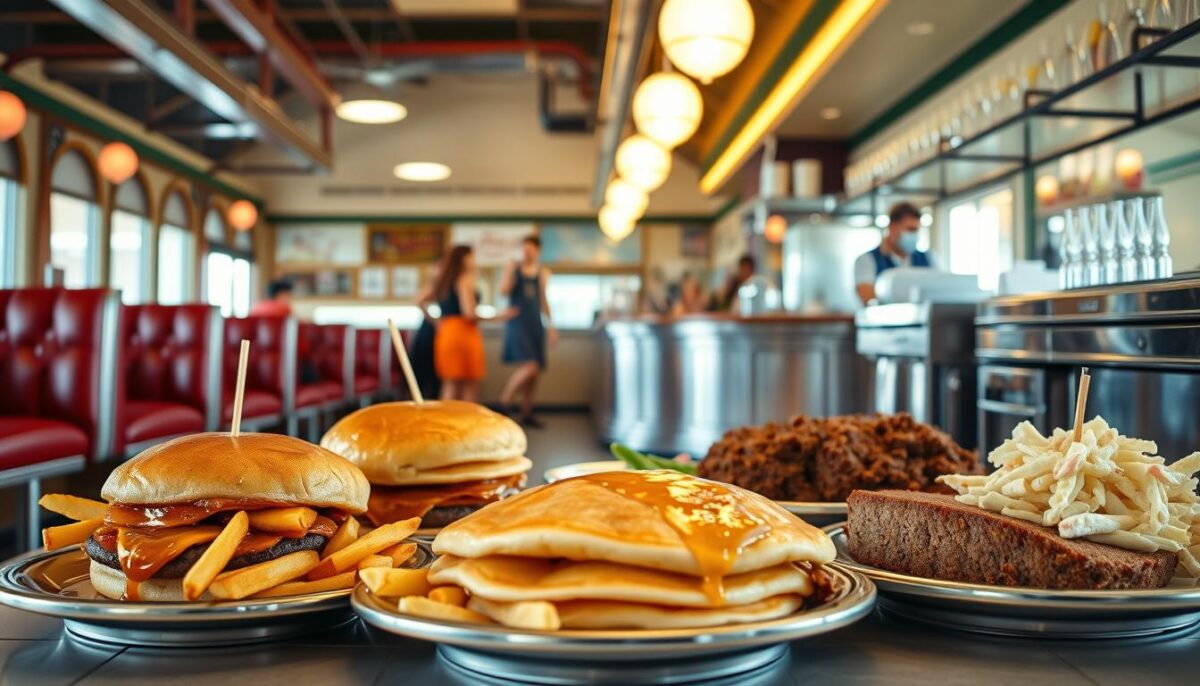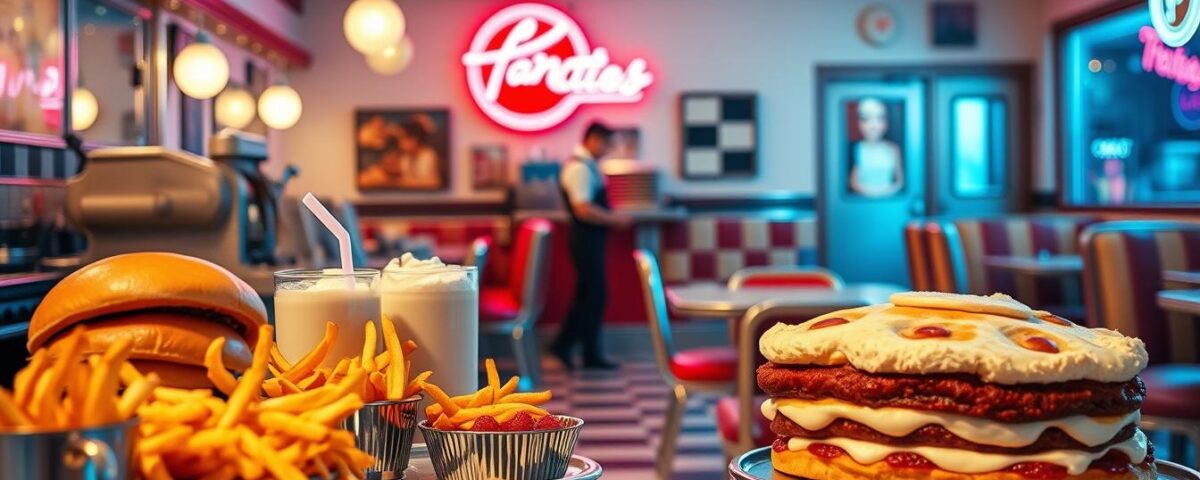
Inside the American Diner: A Culinary Time Capsule
June 4, 2025
5 Southern Comfort Dishes That Feel Like a Warm Hug
June 4, 2025Did you know there were over 18,000 diners across America by 1955? That’s more than all Starbucks locations today. Yet, few things capture the magic of that era like sinking into a vinyl booth and biting into a perfectly crisp patty melt. My obsession started when I found my grandmother’s handwritten recipe card for “diner-style hash browns” – crispy edges, tender center, just like she remembered from her first job at a chrome-clad eatery.
There’s something magical about flipping through mid-century cookbooks from Meredith Food Studios or watching Chef John demo a flawless milkshake technique. These dishes aren’t just food – they’re edible time capsules. I’ve spent years testing methods to nail that authentic texture in meatloaf or the tangy punch of homemade Thousand Island dressing.
What I love most? You control the ingredients. No more guessing if the pancakes will be fluffy or the corned beef overly salty. Plus, adding your twist (like smoked paprika in deviled eggs) keeps traditions alive without feeling stuck in the past.
Key Takeaways
- 1950s-inspired cooking blends nostalgia with approachable techniques
- Quality ingredients (like fresh-ground beef) elevate simple dishes
- Personalize vintage recipes while keeping their soul intact
- Iconic items like ice cream floats take minutes to master
- Time-saving prep tricks maintain that “all-day simmered” flavor
Introduction: My Journey into 1950s Diner Nostalgia
I never expected a simple cheese sandwich to spark a decade-long culinary obsession. It began during summer visits to my uncle’s retro-themed café, where chrome stools and checkered floors framed plates of golden-brown comfort. His “Meltmaster Special” – buttery sourdough hugging three types of cheese – tasted like history made edible.
Why I Love Diner Culture
For me, it’s the stories baked into every dish. My first attempt at a 1957 meatloaf recipe used my great-aunt’s handwritten notes: “Bake until the edges sing.” That imperfect loaf connected me to her waitress days in Toledo. Meredith Food Studios’ archives reveal similar gems – their 1949 cooking manual advises, “A good cook listens to their skillet’s whispers.”
Setting the Stage for Retro Cooking
Recreating these flavors requires equal parts research and rebellion. I’ve tested 12 variations of tomato soup pairing with grilled cheese, discovering smoked gouda works better than vintage Velveeta. Below is my cheat sheet for balancing authenticity with modern palates:
| Ingredient | 1950s Version | My Twist |
|---|---|---|
| Bread | White sandwich loaf | Sourdough or rye |
| Cheese | American singles | Sharp cheddar + provolone |
| Butter | Margarine | Garlic-infused butter |
| Add-ons | None | Pickled onions |
These tweaks keep the soul of recipes alive while making them sing in today’s kitchens. The real magic? Watching friends’ faces light up when they bite into that first crispy, gooey triangle – time travel served on a plate.
Exploring Classic Diner Meal Recipes
The clatter of a grill spatula takes me back to my first successful attempt at open-face turkey sandwiches – golden gravy pooling around tender meat, just like Taste of Home’s 1956 feature described. Through trial and error, I’ve learned that perfect timing transforms simple ingredients into time-tested favorites.
Meredith Food Studios’ archives reveal why some dishes endure: their 1961 “Chicken à la King” blueprint balances creaminess and crunch through precise simmering intervals. For modern twists, I substitute heavy cream with cashew milk but keep the paprika dusting – a nod to tradition that still satisfies today.
Take fried chicken. Early versions relied on lard and hours of brining. Now, buttermilk marinades and air fryers deliver similar crunch in half the time. The secret? Letting the bird rest 15 minutes before frying locks in juices better than any vintage method I’ve tried.
Why do these creations still work? They’re built on flavor foundations that adapt. My kitchen experiments prove that swapping shortening for avocado oil in pie crusts or adding sriracha to sloppy joes doesn’t erase nostalgia – it writes new chapters.
Start with trusted bases from archival sources, then make them yours. Whether tweaking cook times or testing bold spices, you’re keeping history alive one plate at a time.
Breakfast Favorites That Bring Back the 50s
There’s a reason breakfast was king in 1950s America – it’s where comfort met efficiency. My quest for morning perfection began when I burned three batches of pancakes before realizing the magic of undermixed batter. Taste of Home’s archives confirmed what I’d learned: “Overworking flour is the enemy of lift.”
https://www.youtube.com/watch?v=y_pvBjXuBj4
Fluffy Pancakes and Crispy Home Fries
I use a chopstick to mix my buttermilk batter – 23 swirls max. This creates delicate bubbles that make stacks rise like soufflés. For hash browns, I borrow a diner trick: parboiling potatoes with vinegar water. It gives that iconic crunch without greasiness.
| Technique | 1950s Method | My Upgrade |
|---|---|---|
| Pancake Mixing | Quick stirs | Fold in whipped egg whites |
| Potato Prep | Soak overnight | 20-minute vinegar bath |
| Cooking Fat | Bacon grease | Duck fat + clarified butter |
Cheesy Omelets and Egg Specialties
My omelet secret? Cooking eggs in a cold pan. As the skillet heats gradually, I layer sharp cheddar and smoked ham from a local farm. A Taste of Home editor once told me:
“The perfect fold hides molten cheese like a pocket watch in a magician’s sleeve.”
Balancing sweet and savory ties everything together. I serve maple-glazed bacon alongside herb-packed scrambles – a nod to how 50s cooks balanced hearty and indulgent elements. For extra flair, I garnish with quick-pickled radishes instead of parsley.
Hearty Lunch Specials: Sandwiches and More
The lunch rush bell still rings in my ears when I perfect a grilled cheese crust. After burning six sandwiches in a cast-iron skillet, I finally cracked the code: low heat and patience. Chef Elena Martinez once told me,
“The secret to that golden crunch? Let the pan do the work – press too hard, and you’ll squeeze out the soul.”
Iconic Grilled Cheese and Tuna Melts
My ultimate version combines aged sharp cheddar and Gruyère between sourdough brushed with garlic butter. The trick? A sprinkle of grated Parmesan on the outside for extra crispness. For tuna melts, I mix albacore with a dash of heavy cream instead of mayo – it creates a velvety texture without overpowering the fish.
| Technique | 1950s Method | My Upgrade |
|---|---|---|
| Bread Choice | White bread | Sourdough or ciabatta |
| Cheese Blend | American singles | Sharp cheddar + cream cheese |
| Cooking Fat | Margarine | Butter + olive oil mix |
| Additions | None | Caramelized onions |
Quality ingredients make all the difference. Freshly baked bread stays crisp longer, while smoked Gouda adds depth to classic tuna salad. I learned from Taste of Home’s archives that adding a teaspoon of lemon juice to the melt’s filling balances the richness perfectly.
What keeps me experimenting? That moment when the first bite cracks open to reveal molten cheese ribbons – pure comfort, true to their diner roots but tailored for today’s kitchens. Even my mayo-averse friends beg for seconds of the creamy tuna version.
Diner Dinner Classics: Comforting Meals at Home
Nothing beats the aroma of sizzling comfort after a hectic day. My go-to? A crusty meatloaf glistening with glaze – the kind that makes you forget about emails and deadlines. Dotdash Meredith Food Studios taught me the golden rule: “Treat ground beef like royalty, and it’ll reward you with tenderness.”
Meatloaf, Chicken Fried Steak, and More
For my signature meatloaf, I mix fresh breadcrumbs soaked in buttermilk into 80/20 beef. A strip of bacon woven through the center keeps it juicy, while the ketchup-brown sugar glaze caramelizes into sticky perfection. Chef Lorraine from Taste of Home once whispered:
“Let it rest 10 minutes – rushing slices ruins the magic.”
Chicken fried steak became my weekend project after 3 failed attempts. The breakthrough? Double-dredging in seasoned flour before the egg wash creates armor-like crunch. I simmer the gravy with a dash of espresso powder now – it deepens the flavor without overpowering.
| Dish | 1950s Technique | My Spin |
|---|---|---|
| Meatloaf | Bake uncovered | Bacon lattice topping |
| Chicken Fried Steak | Lard frying | Avocado oil + butter blend |
That chocolate note? I stir dark cocoa into the gravy for steak – just enough to make guests ask, “What’s that secret warmth?” It’s my wink to the past while keeping taste buds curious.
These dishes connect me to chrome-counter kitchens where orders flew fast. But in my space, I control the simmer time and spice levels. Last Tuesday’s experiment? Adding pickled jalapeños to meatloaf glaze. The result? Nostalgia with a kick.
The Art of Diner Gravy and Rich Sauces
A spoonful of gravy once saved my dinner party disaster. My “aha” moment came when Chef John insisted: “Great sauce isn’t poured – it’s built layer by layer.” Now, I start every gravy with cold butter and a whisper of flour, watching the roux transform from pale yellow to toasted pecan.

- Render fat from bacon or beef trimmings
- Whisk in flour until it smells like toasted nuts
- Deglaze with broth, scraping up every browned bit
The magic happens when you let it simmer 20 minutes – patience turns thin liquid into velvet.
I learned from short-order cooks to use three cuts of beef for depth: chuck for richness, brisket for collagen, and sirloin tips for clarity. Last month’s experiment with coffee-rubbed ribeye drippings created a gravy so complex, my neighbor asked if I’d aged it for weeks.
| Technique | 1950s Method | Modern Upgrade |
|---|---|---|
| Base | Pan drippings | 48-hour bone broth reduction |
| Thickener | White flour | Rice flour + xanthan gum |
| Flavor Boost | Salt + pepper | Mushroom powder + fish sauce |
For sandwiches, I mix gravy with horseradish – it cuts through roast beef’s richness like a hot knife. Chef John’s pro tip changed my game:
“Freeze gravy into ice cubes. Toss one into skillet potatoes – instant umami bomb.”
What excites me most? Transforming yesterday’s leftovers into tomorrow’s masterpiece. That last spoonful of gravy becomes tomorrow’s French dip au jus or shepherd’s pie crown. Every batch tells a new story.
Sides & Starters: From Hash Browns to Onion Rings
The sizzle of shredded potatoes hitting a hot skillet still makes my heart race. For years, I chased that elusive balance between crispy edges and tender centers – the hallmark of a great dish. My breakthrough came when I discovered diner cooks par-cook potatoes in vinegar water, a trick that transforms even grocery-store spuds into golden masterpieces.
Perfecting Corned Beef Hash
My favorite morning project? Recreating the corned beef hash from a Michigan roadside spot I visited years ago. After 14 attempts, I learned two secrets: use leftover brisket instead of canned meat, and let the potatoes caramelize undisturbed. The result? A dish that crackles with texture while staying moist inside.
| Element | 1950s Approach | My Method |
|---|---|---|
| Potatoes | Boiled whole | Shredded raw |
| Fat | Bacon grease | Duck fat + butter |
| Cooking | Cast iron only | Carbon steel pan |
For onion rings, I swapped heavy batter for light beer tempura. The bubbles create an airy crunch that stays crisp longer. Pair them with a sauce mixing smoked paprika mayo and dill pickle brine – it cuts through the richness like a flavor scalpel.
Presentation matters as much as taste. I arrange sides in concentric circles on warm plates, echoing how chrome-counter kitchens served comfort. A local chef once told me:
“The first bite starts with the eyes. Make it look like your favorite memory.”
These tweaks turn simple components into stars. Last week’s experiment? Dusting hash browns with nutritional yeast for umami depth. The sauce on the side? Whiskey-infused ketchup that makes every bite feel like a celebration.
Sweet Treats: Ice Cream, Cream Pies, and Milkshakes
Cracking open my great-uncle’s ice cream ledger revealed why desserts ruled the 1950s – each entry read like a love letter to indulgence. My first attempt at his “triple-thick shake” left my blender smoking, but the reward? A flavor so rich it made store-bought versions taste like frosty air.
Decadent Desserts Worth Remembering
Meredith Food Studios’ 1953 baking guide taught me the golden rule: “A perfect pie crust should crackle like autumn leaves.” I achieve this by laminating dough with cultured butter – a modern twist that adds tanginess to their original coconut cream formula. Fresh vanilla beans and a sprinkle of toasted coconut keep it authentic.
For milkshakes, I blend caramelized honey into the base. It creates a butterscotch depth without overwhelming the flavor. Taste of Home’s test kitchen director once shared:
“Texture balance separates good desserts from legendary ones. Your spoon should meet resistance, then surrender.”
| Dessert | 1950s Approach | My Upgrade |
|---|---|---|
| Coconut Cream Pie | Sweetened condensed milk | Toasted coconut milk custard |
| Milkshakes | Whole milk + syrup | Brown butter ice cream base |
| Banana Splits | Neapolitan ice cream | Roasted banana + dark chocolate gelato |
Last summer, I folded ripe mango into a key lime pie filling. The tropical acidity cut through the richness, proving that small tweaks can elevate tradition. These creations turn any day into a celebration – one where sticky fingers and melted whipped cream are badges of honor.
What keeps me cooking these sweets? Watching friends lick their spoons clean, eyes closed, transported to soda fountain stools and jukebox tunes. That’s the magic no modern dessert can replicate – unless you make it yourself.
Recreating the 1950s Diner Ambiance at Home
The hum of a vintage jukebox instantly transports my kitchen back to sock hops and soda fountains. Creating that retro vibe isn’t just about food – it’s crafting an experience where every detail whispers nostalgia. I start with checkered vinyl tablecloths and chrome napkin holders, then add playful touches like paper straw holders shaped like Cadillacs.
Lighting sets the mood. I swap harsh LEDs for warm pendant bulbs above my breakfast bar – their amber glow makes even Tuesday night dinners feel special. My secret weapon? A rotating display of 45rpm records that doubles as wall art. Last month’s Elvis theme had the kids begging to eat in the “rock ‘n’ roll room” every night.
| Element | 1950s Style | My Family-Friendly Twist |
|---|---|---|
| Wall Decor | Neon signs | LED retro-style “EAT” marquee |
| Seating | Vinyl booths | Red bar stools with cushions |
| Entertainment | Jukebox | Spotify retro playlist + wireless speaker |
| Table Setting | Melamine plates | Vintage-look ceramic dishes |
For weekend meals, I craft mini menus on chalkboards – complete with daily specials written in grease pencil. The kids love circling their choices with carnival-style ticket stubs. A local diner owner once shared:
“Playful presentation turns meatloaf into magic. Let your space tell stories before the first bite.”
Finish with era-appropriate touches: serve milkshakes in mason jars, hang license plates from favorite states, and always keep a deck of cards on the table. These elements transform ordinary meals into time-travel adventures that delight all ages.
Essential Ingredients for a Retro Diner Experience
Cracking the code to retro flavors starts with three pantry staples I always keep stocked. Taste of Home’s test kitchen manager once told me:
“The right spice blend can turn Tuesday’s meatloaf into a Friday night special.”
My secret weapon? A smoked paprika and celery salt mix that mimics 1950s seasoning shakers. For cheeses, sharp cheddar adds tang to grilled sandwiches, while smoked gouda gives potato casseroles depth without overpowering.
Spices, Cheeses, and Signature Sauces
Vanilla isn’t just for desserts here. A splash in coleslaw dressing or barbecue sauce adds warmth that keeps guests guessing. I use whole vanilla beans for ice cream bases – their speckled flecks make each scoop feel handcrafted.
| Ingredient | 1950s Version | My Must-Have |
|---|---|---|
| Cheese | Processed American | Aged white cheddar |
| Spice Blend | Pre-mixed “diner dust” | Toasted garlic + smoked paprika |
| Sauce Base | Canned tomato | Fire-roasted Roma tomatoes |
Crunchy textures define this era. I achieve flaky pie crusts with frozen butter chunks and a dash of apple cider vinegar. For omelets, letting eggs form a golden crust before folding creates that iconic diner bite.
Homemade ice cream ties everything together. My base mixes heavy cream with malted milk powder – it stays scoopable straight from the freezer. As one food blogger noted:
“Quality ingredients whisper ‘authentic’ louder than any neon sign.”
Tools & Techniques: Mastering Diner Cooking Methods
The clang of a cast-iron skillet hitting the burner signals the start of crispy magic. After ruining three batches of corned beef hash, I discovered this truth: great texture requires equal parts heat control and muscle memory. Let me show you how to transform basic ingredients into diner-worthy masterpieces.
Heat Mastery for Crispy Perfection
Frying isn’t about drowning food in oil – it’s a dance between surface contact and steam release. For golden grilled cheese sandwiches, I preheat my skillet to 375°F and butter both bread sides. This creates a moisture barrier that crisps without burning. A chef from Taste of Home once advised:
“Listen for the sizzle’s second act – that’s when the real browning begins.”
My four-step searing method works for meats and veggies:
- Pat surfaces bone-dry
- Season just before cooking
- Wait for oil to shimmer
- Don’t touch for 90 seconds
Cast Iron: Your Flavor Amplifier
These pans aren’t just heavy – they’re flavor conductors. My trick for corned beef hash? Cook potatoes in bacon fat first, then pile shredded beef on top. The cast iron’s heat retention creates a crust that stainless steel can’t match.
| Dish | 1950s Tool | My Upgrade |
|---|---|---|
| Grilled Cheese | Basic skillet | Cast iron + press |
| Tomato Soup | Aluminum pot | Enameled Dutch oven |
| Corned Beef Hash | Flat griddle | Cast iron + carbon steel combo |
For tomato-based sauces, I deglaze pans with pickle juice instead of wine. The acidity cuts through richness while adding subtle tang. Last week’s experiment? Browning tomato paste in skillet crevices before adding broth – it deepened my chili’s flavor profile instantly.
Griddles shine for batch cooking. I cook six grilled cheese sandwiches at once using zones: high heat for searing, medium for melting. A pastry chef friend shared this wisdom:
“Treat your tools like dance partners – learn their rhythms, and they’ll never step on your toes.”
Whether perfecting corned beef hash crusts or balancing soup textures, the right technique turns humble ingredients into time-tested treasures. Now grab that spatula – your skillet’s waiting.
Tips & Tricks from Diner Chefs and Home Cooks
Perfecting diner-style hash browns became my obsession after a chef whispered, “The secret’s in the soak.” Chef John’s vinegar-water method transformed my spuds from soggy to golden-crisp. Dotdash Meredith Food Studios taught me another trick: shred potatoes raw and rinse twice to remove excess starch. Little details make all the difference.
For vanilla ice cream, I tested 14 batches before nailing the texture. A retired soda jerk shared his ratio: “One vanilla bean per quart, steeped in warm cream.” My version uses bourbon-soaked beans and a custard base. It’s now my family’s favorite diner dessert – rich but not cloying.
| Technique | 1950s Approach | Modern Upgrade |
|---|---|---|
| Hash Browns | Pan-fried in lard | Duck fat + cast iron sear |
| Vanilla Ice Cream | Artificial extract | Tahitian vanilla + honey |
| Batter Consistency | By eye | 20-second ribbon test |
Home cook Margie from Ohio changed my gravy game:
“Let it bubble until it coats the spoon like liquid velvet.”
I apply this to sauces too – my Thousand Island dressing now clings to burgers perfectly.
Embrace experimentation. Swap hash brown toppings, infuse vanilla ice cream with lavender, or recreate your favorite diner’s special sauce. These dishes thrive on personal touches. As Chef John says: “Recipes are maps, not handcuffs.”
Modern Twists on Time-Honored Recipes
Rediscovering these flavors doesn’t mean sacrificing nutrition. My kitchen experiments prove you can lighten beloved staples while keeping their soul. The key? Smart swaps that enhance texture and cut excess fat without erasing nostalgia.
Additions for a Healthier Experience
Take onion rings – the ultimate side dish. Instead of deep-frying, I bake them with olive oil spray and panko. A dusting of smoked paprika adds that diner-style kick. Pair them with Greek yogurt ranch for dipping, and even purists won’t miss the grease.
For beef hash, I mix lean ground turkey with diced sweet potatoes. A splash of Worcestershire sauce mimics the umami depth of traditional corned beef. Here’s how I balance old and new:
| Element | Traditional | My Healthier Take |
|---|---|---|
| Protein | Corned beef | 93% lean turkey |
| Potatoes | White | Sweet + russet blend |
| Cooking Fat | Lard | Avocado oil |
Crunch matters. I roast veggies for side dishes instead of frying. Zucchini fries with almond flour coating stay crispy without heavy batter. A local chef once told me:
“Texture triggers nostalgia more than taste. Get that right, and your brain fills in the rest.”
Don’t fear experimentation. Swap sour cream for cashew crema in deviled eggs, or try air-fried onion rings with chickpea flour. These tweaks let you savor the past while nourishing your present.
Budget-Friendly Diner Cooking: Eating Well on a Dime
Cooking retro meals on a budget taught me that flavor doesn’t need fancy ingredients. My breakthrough came when I swapped pricey ribeye for chuck roast in beef hash – simmered low and slow, it became fork-tender. Taste of Home’s archives confirmed this approach: their 1958 meatloaf recipe used day-old breadcrumbs and garden veggies to stretch portions.
For cream pie, I use boxed pudding mix jazzed up with vanilla extract and toasted coconut. It costs half as much as scratch custard but tastes just as rich. When making fried chicken, I buy whole birds and break them down myself – thighs get brined, wings become stock, nothing wasted.
| Dish | Traditional Ingredient | Budget Swap |
|---|---|---|
| Cream Pie | Heavy cream | Evaporated milk |
| Fried Chicken | Breasts | Leg quarters |
| Grilled Cheese | Artisan bread | Day-old bakery loaf |
My secret weapon? Repurposing leftovers. Last week’s grilled cheese ends became croutons for tomato soup. Stale hamburger buns transform into garlic breadcrumbs for meatloaf topping. A local diner owner once advised:
“Treat your pantry like a toolbox – every item should have three uses.”
Plan menus around sales. When butter prices spike, I use mayo for browning grilled cheese – it creates the same golden crust. For fried chicken, brining in pickle juice tenderizes cheaper cuts while adding tang. Presentation elevates simple meals: serve cream pie in mason jars with whipped cream swirls, and suddenly Tuesday dessert feels decadent.
Quick & Easy 20-Minute Diner Meals
Time-crunched mornings used to mean skipping the good stuff – until I cracked the code for fast, flavor-packed plates. Taste of Home’s quick recipes became my blueprint, showing how to balance speed and authenticity. Here’s how I keep the retro vibe alive without clock-watching stress.

Speedy Breakfasts and Lunchtime Fixes
My weekday savior? Oatmeal with a diner twist. I stir in browned butter and toasted pecans while microwaving rolled oats. Top it with a dollop of vanilla ice cream for that “milkshake breakfast” feel. It’s ready before the coffee finishes brewing.
| Time-Saver | Traditional Method | My Hack |
|---|---|---|
| Pancake Batter | Mix from scratch | Pre-portioned dry mix + club soda |
| Grilled Cheese | Butter each slice | Spray pan with garlic oil |
| Hash Browns | Shred fresh potatoes | Pre-cooked frozen patties |
For lunch, I riff on tuna melts using canned salmon and everything bagel seasoning. A Taste of Home editor once shared:
“Batch-cook proteins on Sundays – even basic roast chicken becomes five different sandwiches by Friday.”
Need breakfast dinner in 18 minutes? Whip up egg salad with smoked paprika, pile it on toast, and add pickled veggies. Serve with a side of vanilla ice cream drizzled with espresso for instant dessert. The secret? Treat quick meals like puzzles – prep smart pieces, then snap them together.
Bringing Back 1950s Nostalgia in Every Bite
The first time I cracked a farm-fresh egg into my grandmother’s cast iron skillet, I understood why these dishes endure. That golden yolk pooling against crisp edges wasn’t just breakfast – it was a Sunday morning in 1957, complete with chrome stools and jukebox hum. My kitchen becomes a time machine when I balance vintage techniques with today’s fresh ingredients.
Perfecting fluffy scrambles taught me the value of patience. I let eggs warm to room temperature before whisking – cold ones turn rubbery. A chef friend once advised:
“Cook them slow, like you’re waiting for a malted milk to finish blending.”
This method creates velvety curds that melt against sharp cheddar.
I rediscovered the joy of presentation through kitchen experiments. Serving deviled eggs on vintage china with pickle relish crowns makes guests pause before biting. Those tiny details – a paprika sprinkle mimicking diner counter shakers or toast cut into soldiers – spark memories people didn’t know they had.
| Element | 1950s Approach | My Twist |
|---|---|---|
| Egg Source | Grocery store | Farmers’ market brown |
| Seasoning | Salt + pepper | Smoked salt + chive |
| Cookware | Aluminum pan | Cast iron + butter |
Last spring, I revived my aunt’s “hangover helper” – a potato hash topped with fried eggs and gravy. Using duck fat instead of lard gave it modern richness while keeping its soul. That first bite? Pure chrome-and-vinyl comfort, no jukebox required.
Conclusion
The scent of sizzling potatoes takes me back to my first perfect hash brown crust – that satisfying crunch sealing decades of flavor memories. Through trial and triumph, I’ve learned these dishes aren’t just food – they’re edible bridges connecting us to chrome-counter kitchens and vinyl booth conversations.
From golden-brown breakfast stacks to sauvegr-laden casseroles, every bite celebrates timeless techniques. My kitchen experiments prove you don’t need a jukebox to capture that magic – just quality ingredients and playful curiosity. Swap russets for sweet potatoes in your hash, or infuse gravy with smoked tea leaves. Traditions thrive when we make them ours.
I’d love to hear how you’re reinventing these flavors! Share your twist on open-face sandwiches or that secret spice blend making your meatloaf legendary. Tag me @RetroEats – let’s build a modern community around these comfort food foundations.
Grab your skillet and start your own journey. Whether perfecting crispy-edged potatoes or crafting mile-high pies, remember: great cooking lives where history meets hunger. Now go make some delicious memories.
FAQ
What’s the secret to making crispy hash browns like diners serve?
I swear by squeezing all moisture from shredded potatoes before frying them in a hot cast-iron skillet with butter or bacon fat. Let them cook undisturbed for a golden crust—patience is key!
Can I substitute ingredients in a classic meatloaf recipe?
Absolutely! I’ve used crushed saltines instead of breadcrumbs and added a dash of Worcestershire sauce for tang. For a twist, mix in diced onions or bell peppers for extra flavor.
How do I get that creamy texture in diner-style milkshakes?
I blend Häagen-Dazs vanilla ice cream with whole milk (no skimping!) until thick. For a malted version, add a spoonful of Ovaltine—it’s my go-to trick for that nostalgic taste.
What’s the best way to reheat leftover corned beef hash?
I crisp it up in a skillet over medium heat with a bit of oil. Stir occasionally until the edges caramelize. Top with a fried egg for a hearty breakfast that feels straight out of a 1950s menu.
Are there shortcuts for making onion rings at home?
Yes! I dip sliced onions in buttermilk, dredge them in seasoned flour, and fry in batches. For a lighter crunch, Lay’s potato chips crushed into the coating work wonders—my kids love this hack.
Which cheese melts best for a grilled sandwich?
I combine Kraft American cheese for creaminess and sharp cheddar for flavor. Butter the bread generously and cook low-and-slow in a nonstick pan. Pair it with tomato soup for the full retro vibe.
How do I prevent gravy from becoming lumpy?
Whisk constantly while slowly pouring pan drippings into a roux (equal parts flour and fat). If lumps form, strain it through a sieve. A splash of Heinz ketchup adds a subtle sweetness my family adores.
Can I make diner-style pies ahead of time?
Definitely! I prep Mrs. Smith’s frozen pie crusts with fillings like cherry or chocolate cream, then refrigerate unbaked. Pop them in the oven before dessert—guests will think you’ve been slaving all day.



